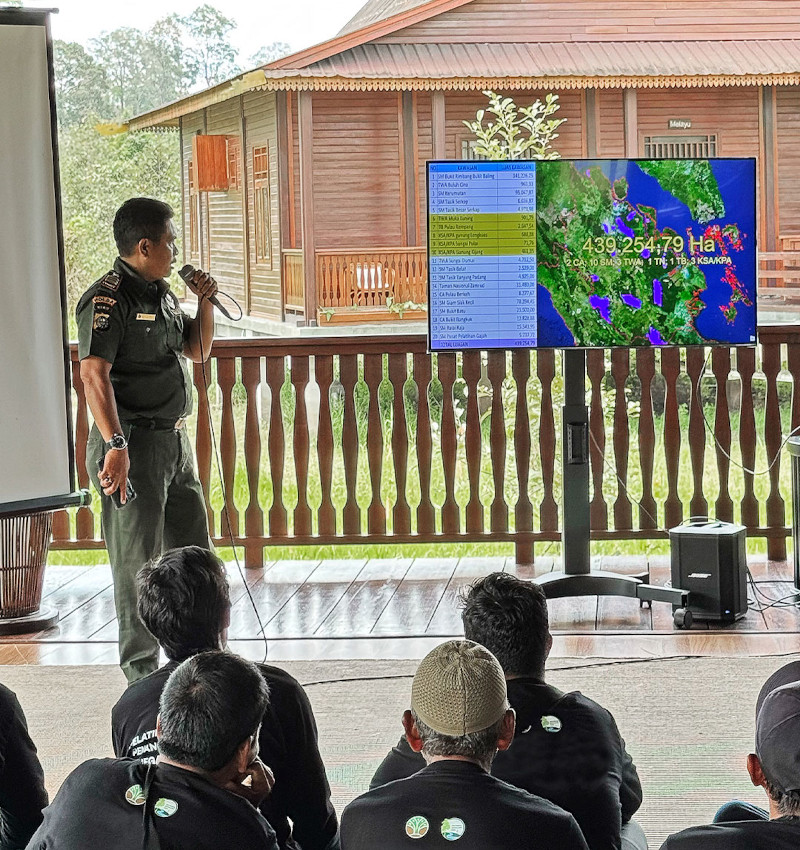November 26, 2025
Humans and wildlife exist side by side within the Restorasi Ekosistem Riau (RER) concession area, which can lead to conflict. This competition can impact livelihoods and, in turn, lead to retaliation that may cause injury or even death to wildlife.
As defined by the Indonesian Ministry of Forestry Regulation (Permenhut 48/2008), human-wildlife conflict encompasses any interaction between humans and wildlife that negatively affects human social life, economy, or culture, as well as the conservation of wildlife and/or its environment.
To help deal with these challenges, RER collaborated with BBKSDA Riau to hold a Wildlife Conflict Mitigation and Handling Training for both RER staff and local communities. The aim was clear: conservation success is measured by the ability of both people and wildlife to thrive together.

The Causes of Human-Wildlife Conflict
The roots of human-wildlife conflict are complex and multifaceted, going beyond simple resource competition to include broader pressures. Key drivers identified during the training include habitat conversion, competition for resources such as food and water, illegal hunting and poaching, forest fires, and operational factors such as harvest patterns.
Species frequently involved in conflicts in the region include the Sumatran tiger, sun bear, and crocodiles, with the latter posing a known risk to local fishers.
“I frequently encounter crocodiles while fishing. Once, after retrieving my ‘pengilar’ (fishing net), my boat was nudged by a crocodile. I immediately moved ashore because the crocodile continued to wait beneath the river,” shared Nasir, a local fisherman.
To address these challenges, the strategy is guided by three core principles of human-wildlife management: recognizing the equal importance of humans and wildlife, acknowledging that solutions must be site-specific, and requiring multi-party responsibility at a landscape scale.

Tiga Prinsip Tindakan untuk Pencegahan dan Respons
Pelatihan ini merumuskan pendekatan RER ke dalam tiga prinsip terpadu yang mencakup mitigasi struktural, kesiapsiagaan, dan pola pikir.
1. Mitigasi Struktural: Peralatan dan Deteksi Dini
RER menggunakan teknologi dan perlengkapan lapangan untuk mencegah pertemuan langsung antara manusia dan satwa. Langkah struktural ini mencakup:
2. Mitigasi Non-Struktural: Edukasi, Toleransi, dan Kapasitas
Pendekatan non-struktural berfokus pada perubahan perilaku dan penguatan kapasitas masyarakat melalui edukasi. Pelatihan ini bertujuan untuk mencapai tiga hal: mencegah konflik manusia–satwa liar, meningkatkan toleransi masyarakat terhadap satwa, serta memperkuat kemampuan masyarakat dalam menangani situasi awal sebelum tim khusus tiba.
Perubahan perilaku membutuhkan pergeseran dari respons spontan dan reaktif menjadi tindakan yang terencana dan berdasarkan pengetahuan, dengan prinsip hidup berdampingan. Hal ini mencakup perilaku pencegahan seperti mengamankan hasil panen agar tidak menarik satwa liar, serta menyesuaikan kegiatan harian untuk menghindari koridor pergerakan satwa.
Selain itu, sikap masyarakat juga perlu berubah. Bukan lagi merespons satwa dengan tindakan balasan setelah insiden, tetapi mengikuti protokol respons yang aman. Melalui kegiatan pelatihan seperti lokakarya dan penyebaran informasi, masyarakat dan jagawana RER dibekali pengetahuan penting mengenai perilaku satwa. Pengetahuan ini membantu mereka mengusir satwa dengan cara yang aman tanpa melukai, sekaligus memastikan semua pihak mengetahui jalur pelaporan resmi agar penanganan dapat dilakukan dengan cepat dan profesional.
3. Conservation as an Asset, Not a Threat
Mitigation is also about shaping perspective. RER encourages community involvement — including active participation in early reporting and monitoring of wildlife, and adopting safe response protocols learned through training— in fostering the critical awareness that wildlife is an asset to be protected, rather than merely a threat. This engagement aims to shift the community’s role from recipients of conflict to proactive conservation partners.
Reporting and Monitoring
Human-wildlife conflict management protocols include specific post-conflict steps executed by the Conflict Handling Task Force:
“Until today, we continue to learn about the unique characteristics of each species. Consequently, there have been no recorded negative conflicts between wildlife and humans in the RER area thus far,” affirmed Yoan Dinata, Conservation Manager at RER.
Coexistence is the only viable path toward a sustainable future.